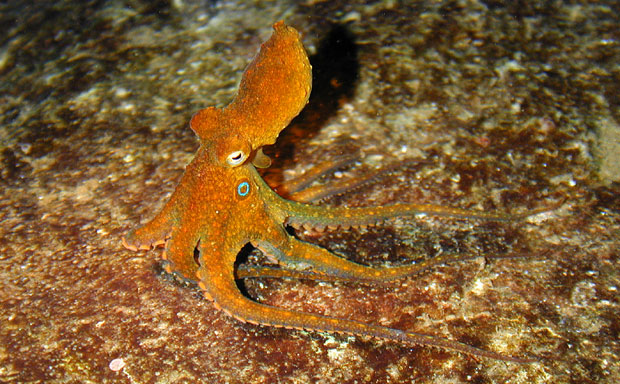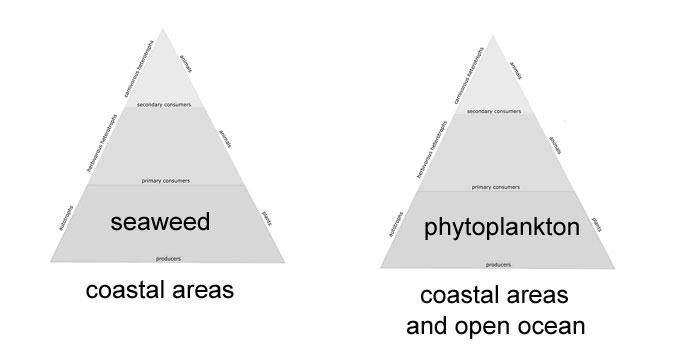Marine Ecosystems| Like all ecosystems, marine ecosystems are mostly self-sustaining systems of life forms and the physical environment. In these ecosystems materials are cycled and recycled. All ecosystems have certain things in common and marine ecosystems have a few unique twists to these cycles. We can begin this discussion with describing the make-up of life forms (critters). |
Baby two spot octopus showing chromatophore cells (in orange and black) that it can use to change color. These cells cover the skin of many octopus species and come in a variety of colors - both orange and black are seen here. The pigment in these cells can be stretched to create different skin colors so that an octopus can either stand out against the background -or- blend in remarkably well. (SA image) |
| Almost all life forms are made of a cell (if they are unicellular) or cells (if they are multicellular) and the products of the cell(s). To sustain life, these cells must carry on a chemical reaction called cellular respiration. |
Cellular respiration equation. |
| Cellular respiration is the life sustaining process for all life forms, including both plant and animal types. It is where a cell uses what we call 'cell food' (a simple carbohydrate molecule - usually glucose made of six carbons, twelve hydrogens, and six oxygens) in the presence of oxygen to make the 'cell energy' (in the form of a molecule we call ATP) and with a waste product of carbon dioxide. The ATP is used to repair the cell and keeps it alive. A few organisms can cellularly respire without oxygen but it is not as efficient and we call these critters 'anaerobes.' Most critters need oxygen to stay alive and 'cell food.' The cell food is obtained by eating in animals (also called consumers) and by photosynthesis in critters we call plants (also called producers). |
 |
| Photosynthesis is the food-making process for producers, which we often call plants. In the marine environment many of the producers are microscopic and classified in a kingdom called Protoctista, along with the algae. But, they are still like plants in that they photosynthesize no matter what group they are classified as. Photosynthesis is where carbon dioxide and water are combined within a specialized part of a cell (called a chloroplast), in the presence of light, to form the 'cell food' molecule called glucose and with a waste product of oxygen. In a sense it is cellular respiration in reverse but it will only happen in cells with chloroplasts (in which there is the molecule called chlorophyll that is involved). It is a complicated reaction but the end product provides the recycling of carbon dioxide back to oxygen for the cycle of these two gases. Without photosynthesis all life forms (plants and animals) would use up the oxygen on Earth and it would only be found as carbon dioxide (not usable in cellular respiration). |
 |
Multicellular adult two spot octopus individual with most of its orange chromatophores turned on so that its skin appears orange. Notice the 'two spots' of blue - where blue chromatophore cells are turned on making spots that appear as large eyes and thus its common name. Its real eyes are just above the fake blue eyes. (GA image) |
| Both unicellular (one celled) and multicellular (more than one cell) individuals are found in the marine ecosystem taking on various levels of interaction. There are unicellular plants and animals. There are multicellular plants and animals as well. The multicellular species may be very simple or more complex with cells specialized as tissues, organs, and organ systems depending on the species. Whether or not a species is simple or complex they each have their place in the ecosystem and interesting stories about their life histories. |
Two (or more) two spot octopods in an area would be a population. Notice that these individuals have turned off most of the orange chromatophores and created a pattern on their skin that almost matches their environment - octopus are very good at blending in due to their chromatophore skin cells. (GA image) |
| Populations are groups of organisms of one species living in an area and interacting. Interactions between individuals of the same species are termed intraspecific interactions and can be positive (like cooperation), negative (like competition) or anything in between. |
A simple community associated with the two spot octopus (seen above, left, out hunting in the tidepools at low tide) would include its food (like the kelp crab, middle) and the food for the kelp crab (kelp, right). In reality the community would be more complex including a variety of food items for the octopus (fish, clams) and other species of kelp for the kelp crab. (GA images) |
| Communities are composed of populations of many species living in an area and interacting. Interactions between species are termed interspecific interactions and, just like with intraspecific interactions, can be positive, negative or anything in between. |
Tidepool habitats of the two spot octopus include many species interacting in a complex community. It could even be considered a small ecosystem because most of the interactions occur here and it is pretty much self-sustaining (although the tide brings in new species and nutrients with each cycle). (GA image) |
| Ecosystems are areas where the community, or communities, are rather self-sustaining. This involves what we call food chains and webs - that is describing who eats who and following the energy flow (in the form of food) all the way to what we call the bottom of the food chain. The bottom is where the producers are found. The producers are the photosynthesizers and depend on carbon dioxide and light so that they can make their own food. Gases are cycled and recycled in ecosystems through cellular respiration and photosynthesis. Nutrients are cycled by decomposers (bacteria and fungi) in ecosystems that are involved with rotting (decomposing) any dead materials and releasing the nutrients from these cells. Food is cycled through what we call trophic pyramids - always with the producers at the base. Ecosystems can be interpreted as very large areas (like the entire planet Earth) or smaller subunits (like a tidepool habitat shown here) depending on how strict one uses the term 'self-sustaining.' |
 |
The trophic pyramid of an ecosystem. Kelp could be placed on the bottom as a producer, the kelp crab on the middle layer (as a primary consumer or herbivore), and the two spot octopus on the top (as a secondary consumer or carnivore). |
| Trophic pyramids in the ocean are similar to those on land with the base always larger than the upper trophic levels. The base is the producers. The second level is the level of the critters that eat the producers (we call these herbivores, or plant eating animals). The third level is composed of critters that eat the herbivores (we would call these carnivores, or animal eating animals). As you move between the levels there is always a loss of biomass because the transfer of energy is usually only ten percent efficient. This means that if there were 100 pounds of producers in an area there would be enough food for 10 pounds of herbivores but the 10 pounds of herbivores could only support 1 pound of a carnivore. So you see, as you move up the food chain (or trophic pyramid) there is a smaller and smaller biomass that can be supported. Sometimes we refer to the second and third levels of the trophic pyramid as primary consumers (the herbivores) and secondary consumers (the first order carnivores). There can be many more levels (each with a loss of 90 percent biomass average) with tertiary consumers (carnivores eating the secondary consumers) and so on. |
 |
Marine trophic pyramids are either seaweed based (coastal areas) or phytoplankton based (coastal areas and open ocean). |
| Marine producers are either seaweeds and/or phytoplankton and must be found where there is enough light for photosynthesis. Therefore the marine producers are always in the upper layers of the ocean, the area we call the photic zone. Animals can be found everywhere, in both the photic and aphotic zones, because they are not limited by light. Most seaweeds grow only attached to the ocean bottom so their distribution is limited to the edges of continents and islands where the depth is within the photic zone. These seaweeds account for only a small portion of the producers in the ocean because they are so geographically limited. Most of the ocean is open ocean, away from the edges of land and over deep water. It is here, near the surface, that the phytoplankton (plant plankton) dominates. Phytoplankton is also found in the same coastal areas as the seaweeds. Both types of producers are important in marine ecosystems however the phytoplankton based ecosystems are more common. The importance of the phytoplankton is one of the things that make marine ecosystems unique and different from land ecosystems because phytoplankton is generally microscopic. Land based ecosystems are based primarily on large land plants but marine ecosystems are based primarily on tiny, microscopic phytoplankters. |
|

